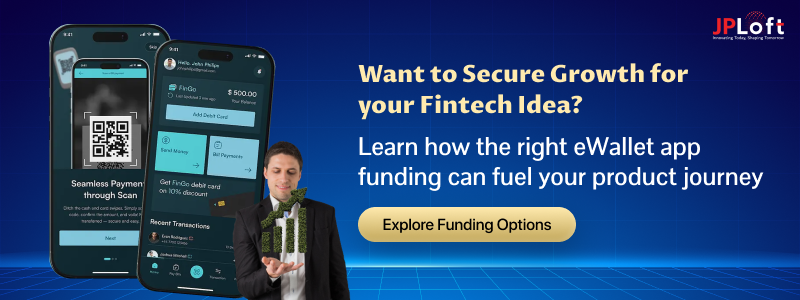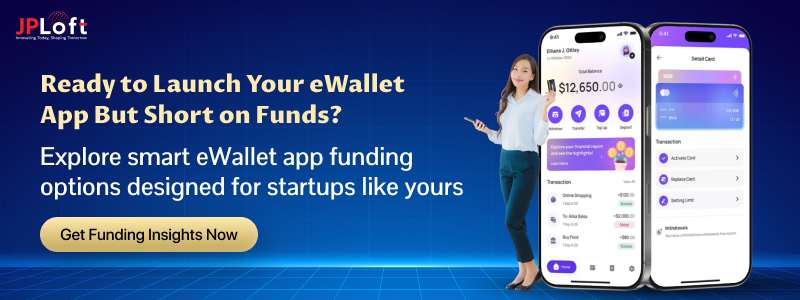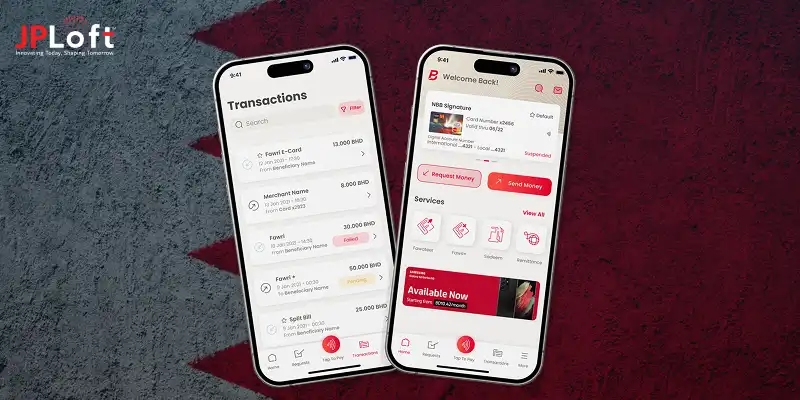Money is the oxygen of every startup.
Without it, even the most brilliant idea remains just that, an idea. The digital payments industry is exploding, and eWallet apps are at the centre of this shift.
But building one takes more than coding skills or a good design. It takes strong financial backing, smart partnerships, and the trust of investors who believe in your vision.
So, how do you get started? How to secure funding for an eWallet app? That’s the question every founder asks when they step into this booming space.
There are several funding strategies for eWallet apps in the market, including bootstrapping, angel investment, venture capital, crowdfunding, and government grants.
From early seed rounds to big-ticket venture capital, you need to know which path fits your business best.
This guide isn’t just theory; it’s about showing you why investors put money into eWallets, how to prepare before you pitch, and what funding really means beyond numbers in a bank account.
What Do We Mean by eWallet Funding?
When people hear the term "funding," they immediately think of investors writing checks. They are right, but that is only the beginning.
When we talk about eWallet app funding, we are talking about resources to successfully take your app idea, develop it into a viable solution, and market it to be competitive in a crowded marketplace.
Without it, you cannot generate the funding needed to move past a basic prototype and earn customers' trust to adopt your solution.
eWallet funding, at its core, covers all the important aspects of growth:
-
Development expenses - funding to build the backends, create secure systems, and develop the app.
-
Compliance & security - funding to comply with PCI DSS, GDPR, KYC/AML, etc., to earn the trust of both the investor and customers.
-
Marketing & growth - funding to drive & acquire users, onboard merchants, and scale (through marketing campaigns).
-
Operations & support - funding to scale customer service, manage transactions, and prop tech maintenance on a daily basis.
When you develop an eWallet app, you are not just building code; you are building a full-fledged digital financial service.
What does that mean for you as an entrepreneur? It means the up-front investment required is going to be more than for a lot of other apps.
This is why investors screen the eWallet landscape for opportunities, taking into consideration how their money will be used.
But here's the positive news: right eWallet app funding does more than just pay bills.
It provides legitimacy for your startup, attracts better partners, and allows you to grow faster than everyone else. In fintech, money = trust.
When someone you respect invests in you, banks, merchants, and end users trust you, too.
So don't only see your funding as capital. You need to see it as fuel + validation—two things your eWallet app cannot live without.
The Growing Opportunity in eWallets (Investor’s Perspective)
The fintech wave is considerable, and eWallets are sitting at the very forefront.
Investors are aware that this isn't a fad: it's a casual shift in how people manage their money. That's why you have never had greater opportunities to get funding for your eWallet app.
To understand the interest from investors, let’s get to know four benefits of getting an e-wallet app.
1. Rising Smartphone Penetration
Smartphones are everywhere, from cities to rural towns, opening access for billions.
This surge makes it easier to secure e-wallet funding since every new phone creates a potential wallet user.
Show investors this link, and you’ll prove you know how to get eWallet funding the smart way.
2. Everyday Use Cases Expanding
Wallets are now used daily- paying bills, booking tickets, or splitting dinner.
This everyday need boosts retention, and that’s what investors value.
For founders, it’s the best time to get eWallet funding because wallets aren’t optional anymore. They’re tools people rely on every single day.
3. Government Push Towards Digital Payments
Governments worldwide support cashless transactions with systems like UPI, open banking, and subsidies. This policy backing reduces investor risk.
Highlighting such moves makes securing funding for an eWallet app easier, as your startup aligns with official initiatives.
Stability plus adoption gives investors more confidence in your long-term success.
4. Untapped Emerging Markets
Billions remain unbanked yet own mobile phones.
For them, wallets are the first step into finance. Startups that target these markets can start an online eWallet business that has huge potential.
That’s why investors are keen to secure e-wallet funding here unlocks scale, loyalty, and growth in regions waiting to be served.
With the growing demand for an eWallet app, it is time to ask the right question:
How to Get Funding for Your e-wallet App?
The ideal way to fund your eWallet app is to select the best option based on your current stage, whether that is bootstrapping or from angel investors, venture capital, crowdfunding, or even government grants.
Each option works differently but ultimately has the same intent of helping you receive the resources necessary to build, scale, and earn acceptance from investors.
Now let's take a look at the fun part—how to fund your eWallet startup.
They all have their advantages, disadvantages, and timelines; knowing which one to choose for your stage can make a huge difference!
1. Bootstrapping Your Startup
Bootstrapping involves using your savings or reinvesting some of the revenue you generate early on to fund your idea.
It's a gutsy start and shows investors you believe in your product.
For eWallet app funding strategies, bootstrapping is good when you want to maintain control and flexibility without external input and are willing to deal with slower growth.
It is usually your first step before moving to larger funding rounds.
Bootstrapping is a common starting point for many fintech startups. They use it to prove traction before investing in external investors.
Pros:
-
You maintain full control over all business decisions
-
There is no dilution of equity in your business
Cons:
-
You will have a much smaller capital to scale
-
There is a high level of financial risk
How to Apply: You may want to fund your MVP with your savings, track your traction, and then reinvest your profits.
2. Angel Investors
Angel investors are affluent individuals who support new businesses in their early stages.
Not only do they provide funding, but they also offer networks, mentorship, and credibility.
For funding in eWallet, angels come in when traditional sources of funding like banks and VCs will not.
They care about vision, addressing a problem, and early signs of traction, such as beta users.
Angel investors are often the first external investors for the founders and provide validation.
If you are scratching your head and thinking of ways to get funding for your eWallet application, then angels are a great way to enter the funding landscape.
Pros:
-
Capital for early-stage
-
Internal expertise in industry
Cons:
-
Smaller ticket sizes
-
Early dilution in equity
How to apply: Join an angel network or pitch at various startup events.
3. Venture Capital (VC)
Venture Capital is what you're mostly relying on when you consider a rapid scale-up. VCs invest when your app is already showing some growth, traction, and readiness for compliance.
VCs write big checks and certainly want to see global ambitions. For e-wallet funding, they will consider retention (and growth), scalability, and your revenue model.
They want to support businesses that are going to be market leaders/monopolies. If your intention is to launch an eWallet business that provides services globally, VC is the fastest way to scale.
But they will want the sales and/or growth curve to be aggressive.
Pros:
-
Potential for large amounts of funding
-
Support for hiring and scaling your movement forward
Cons:
-
You have agreed to a huge ownership loss
-
Significant pressure for growth and results
How to apply: Reach out to informed fintech-dedicated VC firms with legitimate metrics.
4. Bank Loans and Credit Lines
Banks will typically lend to you if you have a strong business model or sufficient collateral with a lean startup.
Loans will not be as flexible as investors. But, loans do provide security and predictable repayment.
Bank loans and lines of credit will work for founders pursuing eWallet app funding if they do not want to give up equity.
The flip side to bank loans is the requirements and the pressure of repayment. If you are a founder who believes you can show us consistent revenue, bank loans are a viable strategy.
Increased understanding of how to get eWallet app funding from banks provides some fiscal independence for you, but only if you can prove consistent revenue and/or financial stability.
Pros:
-
You retain complete ownership
-
Regular loan repayment terms
Cons:
-
You have to put up collateral and/or revenue/operating/sales records
-
You have added "debt" pressure
How to apply: Give a summary of your business and/or business metrics, and put a commercial loan application in.
5. Crowdfunding
Crowdfunding shifts customers into the role of investors.
Using common websites, you can raise small amounts from many backers. It is both funding and marketing, as the supporters often become early adopters.
For startups that test product ideas, crowdfunding is a unique way of funding the eWallet app.
Crowdfunding takes a lot of storytelling and promotion to be successful.
Different methods, such as having investors who always back your campaign of trust and transparency, go a long way.
Investors like to see social proof before investing in more significant future investments.
If you are looking at a creative approach to accessing eWallet funding, crowdfunding can get you both funding and brand awareness at the same time.
Pros:
-
Creates a loyal community
-
Double-dipping on marketing
Cons:
-
Have to promote heavy, heavy, heavy
-
Hard to raise significant equity
How to Apply: Launch your campaign on equity crowdfunding platforms such as Republic or Seedrs.
6. Government Grants and Programs
Various governments support fintech innovation by providing grants, subsidies, and competitions.
Countries such as the U.S., UK, EU, or India have multiple programs to help drive digital payments.
These government programs typically offer non-dilutive grants, which are great for founders who are exploring their options for funding an eWallet.
The major hurdle is strict eligibility and lengthy application processes.
If you want to source funding for your eWallet app, gaining credibility in the form of government support extends trust and legitimacy to your eWallet.
Securing government support as part of your eWallet fund source is a slow burn, but well worth it.
Pros:
-
Non-dilutive funding.
-
Adds official credibility;
Cons:
-
Lengthy approval process.
-
Limited funds available;
How to Apply: Apply through national fintech boards or startup grant portals.
7. Incubators & Accelerators
Incubators or accelerators fund, mentor, and provide resources in exchange for minimal equity.
They are perfect for early founders needing oversight.
For eWallet app funding structures, accelerators aggregate growth with networks & demo days.
Corporate funding isn't huge; however, the real value will always be with mentorship and connections.
If you're trying to figure out how to fund an eWallet app, accelerators provide a sovereign structure and expose you to larger investors in the future.
Pros:
-
Finance mentors & resources
-
Exposure to investors, demo days for accelerators
Cons:
-
Minimal funding
-
Equity share
How to apply: Apply to fintech-focused accelerator programs like Y Combinator or Plug and Play.
8. Corporate Partnerships
Big financial institutions & tech firms often invest in startups that fit within their strategy.
Corporate partnerships for fintech founders mean money, distribution and credibility.
This is an uncommon but potentially lucrative eWallet app funding approach.
On the negative side, as with all corporate engagements, founder reliance on their goals may be unyielding.
Regardless, for those looking for e-wallet secured funding, corporate agreements, satisfaction of money & validation. Investors will also have faith in a startup backed by corporates.
Pros:
-
Strategic support
-
Access to an enormous potential customer base
Cons:
-
Some loss of independence
-
Reliant on corporate priorities
How to apply: Pitch corporates that manifested synergy regarding digital payments.
9. Strategic Partnerships with Banks or Issuers of Payment Instruments
Partnering with banks or issuers of payment instruments can provide access to funds and distribution.
Fintechs find partners in traditional finance to be credible. If you are creating an online eWallet, then these partnerships can be very lucrative.
You trade speed of execution, just to start working with your experienced trade compliance and funding staff.
However, funding via eWallet partnerships assures some stability for your investors. It is some of the most sensible tech funding to create capital and possible long-term stakeholders in the fintech industry.
Pros:
-
Funds your capital and provides an associated trust
-
Increases your potential distribution through their bank customers
Cons:
-
Has slower processes
-
It is detailed with compliance requirements
How to Apply: Present your bank or payment companies with similar-level partnership or cooperation models that will create value for their company.
10. Initial Coin Offers (ICOs) or Token Sales
Blockchain wallets, ICOs, and blockchain token sales provide unique investment opportunities.
As part of your crowdfunding, you can sell digital tokens in return for funds and to develop a community of users.
These tokens can attract savvy investors in cryptocurrency.
If you want funds for your eWallet app using blockchain, ICOs can provide innovative ways for funds to be raised, but it can also be significantly risky, with potential regulatory threats.
ICOs are one of the newest eWallet app funding strategies.
Therefore, it will also be risky due to the regulatory constraints and the need to ensure the proper legal/financial attachments are in place.
Pros:
-
Provides access to global problem-solving crypto investors.
-
Can develop initial users for your eWallet app.
Cons:
-
High regulatory risks.
-
It can be highly volatile in terms of markets.
How to Apply: Hire legal experts and launch tokens on trusted crypto platforms.
As we are done with funding options for your eWallet app, it is now time to
How to Choose the Right Funding Model for Your eWallet Startup?
Choosing how to fund your startup is just as important as building it.
The right choice decides how fast you scale, how much control you keep, and how much risk you take on.
To succeed, you need to carefully secure your eWallet funding options based on your stage, vision, and market.
Let’s break down the smartest ways to decide which model works for you.
1] Match Funding to Your Stage of Growth
Not every source fits every stage. Early on, you may need small eWallet app funds from bootstrapping or angels. Later, VCs or banks become viable.
-
Early Stage: Build and Test: At this stage, focus on MVPs, proof of concept, and traction. Bootstrapping or seed funding is best here. They let you validate without losing control.
-
Growth Stage: Scale and Expand: Once you prove demand, move to larger eWallet app funding options like venture capital or corporate partnerships. These bring big money but also demand results.
2] Consider Control vs. Capital
Do you want to keep full ownership or trade some equity for growth? That choice changes everything.
-
Keeping Full Control: If ownership matters, rely on self-funding, bank loans, or government grants. You retain independence, but growth may be slower.
-
Trading Equity for Speed: If you’re chasing big markets fast, angel investors and VCs are your best bet. With them, you’ll sacrifice equity but gain resources, networks, and guidance.
3] Think About Risk Appetite
Every model comes with risks. Choose one that fits your comfort level.
-
Low Risk: Government programs, crowdfunding, and grants lower personal risk. They protect ownership and provide safer funding for your eWallet app.
-
High Risk, High Reward: VCs push for rapid growth and can take your startup global. But they bring pressure, tough terms, and milestones. If you’re confident in handling eWallet app challenges, this route makes sense.
4] Align with Market Trends and Investor Interests
Investors want to fund businesses that match demand. Keeping an eye on trends in eWallet app adoption helps.
Are people in your market focused on QR payments, cross-border remittance, or crypto wallets? Match your model to the investors chasing those trends.
5] Factor in Compliance and Regulations
Fintech is regulated heavily. Any investor will ask how you’re handling compliance. This is part of the eWallet app’s funding decisions since some backers—like banks—will only invest if you have licenses in place.
- Compliance Costs Add Up: Getting PCI DSS, KYC/AML, or GDPR approval takes time and money. Plan funding with this in mind.
- Investor Confidence: If compliance is strong, investors feel safer. That’s the key to ewallet secure funding from traditional financial institutions.
6] Focus on Features and Differentiation
Investors are flooded with fintech pitches, so your app must stand out. Strong eWallet app features can become your biggest selling point when attracting capital.
Think of biometric security, AI-driven spending insights, or seamless cross-border payments.
If your product solves unique pain points, you gain leverage in picking the right backers. Differentiation makes it easier to close deals and secure funding that matches your long-term vision.
- Show What Sets You Apart: Highlight features that users love and competitors lack. Investors want proof that your app has stickiness.
- Align Features with Investor Goals: If an investor focuses on security or cross-border markets, stress those features in your pitch.
- How to apply: Document standout features in your pitch deck and connect them to growth potential.
7] Diversify When Possible
Relying on one funding source is risky. Smart founders mix strategies—bootstrapping to build an MVP, angels for early scaling, and VCs for rapid expansion.
This layered approach balances independence with growth. Diversifying also shows investors you understand risk and resilience, making them more likely to trust you.
It’s a key move for long-term eWallet app funding options success.
- Balance Control and Growth: Keep early ownership with bootstrapping or grants, then bring in equity-based funding when scaling.
- Reduce Dependency Risks: If one funding path dries up, you still have alternatives. Diversification keeps your startup flexible.
With this being done, let’s get to know about how to pitch for funding of your eWallet app to your investors:
How to Pitch Investors for Your eWallet App Funding?
Pitching is about clarity and proof.
You need to secure your eWallet funding by showing why your idea matters. Investors like numbers, growth paths, and trust.
The right eWallet app funding strategies make your pitch stronger and easier to believe.
► Show the Market Demand
Investors want proof that people need your product.
Share clear numbers on app downloads, payment habits, and digital wallet use. Point out trends that highlight the growth of mobile payments.
This simple step makes your eWallet app funding strategies look practical and data-backed.
► Highlight Your Unique Features
Every app lists payments and transfers. That’s not enough.
Show what sets you apart: security, rewards, or speed. Emphasise your strong eWallet app security since investors care about safe transactions.
Stressing these points makes your strategies for eWallet app funding more convincing and memorable.
How to Pitch Investors for Your eWallet App Funding?
Pitching involves clarity and evidence.
To secure ewallet funding, you'll want to demonstrate why your idea matters. Investors are interested in numbers, pathways for growth and trust.
The right eWallet app funding strategies are those that will strengthen and enhance the credibility of your pitch.
A] Illustrate Market Demand
Investors will not invest in your product until you can show them that there is proof of need.
You will want to share good data illustrating app downloads, payment practices, and growing digital wallet users. Highlight trends that demonstrate growth in mobile payments.
Simply following this one step will show that your eWallet app funding strategies are feasible and data-driven.
B] Showcase Your Unique Offerings
Every app mentions payments and transfers; the key question is, what will distinguish your app from the others?
Focus on what differentiates you - security, rewards, or speed. Don't be afraid to focus on eWallet app security. Investors want to know that transactions will be safe.
Stressing these elements will make your eWallet app funding strategies more credible, understandable, and memorable!
C] Break Down Your Revenue Nodel
Be as simple as possible.
Explain how your eWallet makes money from fees or subscriptions or merchant connections.
A clear model reinforces the confidence that your app can scale. One of the strongest revenue plans is the best tactic for E-wallet app funding success.
D] Prove Growth Potential
Investors love apps that can grow rapidly. Show how you will grow into new regions, old features, or add value from new partners.
Share how your tech stack of eWallet apps allows you to scale at a lesser cost. When you show scale, your eWallet app funding request looks like a good deal.
E] Build Trust with Numbers
Numbers make or break any pitch.
Share user adoption projections, customer lifetime value, and cost breakdown. Keep it realistic, clear, and simple to follow.
Honest numbers breed trust. This is also an industry-standard component in eWallet app funding strategies that will be respected by investors.
F] End With a Clear Ask
Don't close weak.
Clearly state the exact amount you are looking for and what you will do with it. Relate the funding request to features or growth measures.
A strong close signals you are a serious player. A clear closing makes the eWallet app funding pitch clear and strong.
Once you get your hands on the funding for your eWallet app, you need to know where to go. We suggest going straight to a mobile app development company with your idea to make it a reality.
But, you must be wondering what metrics investors use to evaluate eWallet startups.
Key Metrics Investors Are Looking For to Evaluate eWallet Startups
When pitching, numbers are more powerful than stories.
When looking for funding for your digital wallet app, you need to show the right metrics to your potential investors. Investors want to see proof of growth, proof of safety, and proof of long-term returns.
The right funding options for your eWallet app will become easier to unlock when you present data they can trust.
1. Financial Metrics
Numbers show whether your business can earn and retain revenue.
-
CAC vs LTV With Fintech Examples
When considering an eWallet app, investors want to know the cost of acquiring a user vs the LTV of the user over time.
When your LTV > CAC, you prove potential for profit.
When you communicate a solid CAC vs LTV ratio, it makes your eWallet app funding options more exciting for the investor.
-
Gross Margin and Time to Break-Even
Margins are important. Show the amount of margin (i.e. profit) you will keep after costs.
Share how long until the app becomes profitable and investors can expect returns.
Emphasizing and communicating margins builds confidence and allows your mobile wallet app's funding options to look solid and realistic.
2. User Engagement Statistics
Engagement shows if people love and use your app regularly.
-
MAU/DAU, churn rate, and stickiness
Monthly active users (MAU) or daily active users (DAU) tell how regularly people use your app.
Churn shows how many people leave your app each month. Stickiness shows loyalty to your app. This proves user engagement and goes hand-in-hand with building your case for a funding request for your eWallet app.
-
Transaction Volume Growth as a Confidence Signal
Transaction volume growth is better if you grow faster.
Transaction growth shows demand increasing and increasing trust. This shows proof of scale as well.
Strong growth metrics can get investors to approve your eWallet app funding plans without a second thought.
3. Security Metrics
Safety is a top priority for investors in fintech apps.
-
Fraud Detection Rates
Fraud kills trust pretty fast. Demonstrate how your systems detect and block fraud in a timely manner. Strong fraud detection lowers risk and improves investor confidence.
Safety plays an important role in funding strategies for mobile wallet apps because investors won't invest in weak security.
-
Compliance Certifications Achieved
Investors care about compliance. Display any certifications like PCI DSS or ISO that show your app is in compliance with regulations.
Certifications provide a safety badge to your pitch and show that your digital wallet app's funding strategies have the backing of trust and standards.
Now that you know the key metrics that investors are looking for, let’s take a look at how those numbers play out in real-life eWallet startups and their funding pathways.
4. Technology Metrics
Investors want to know if your app has the capacity to scale with advancements in technology.
-
AI in finance for smarter insights
AI is reshaping how payments, risk checks, and fraud alerts function.
If you can demonstrate to investors that you are using AI in finance, it builds legitimacy for your model.
In that case, you can partner with an AI app development company, which also validates that your app has the supporting level of technical depth required to gain funding.
-
Shifting with New App Trends in eWallets
Technology shifts quickly!
Showing investors that your eWallet app has options like biometric login, QR-based payments, or blockchain-backed transfers lets them see your ability to keep up with tech.
If your positioning continues to align with eWallet app trends, it tells investors that your platform will not become obsolete.
It makes your eWallet app funding strategies look better and more future-ready.
With the financial, user, security, and tech metrics in place, the next step is seeing how successful eWallet apps applied these strategies in the real world.
Real-World Case Studies of eWallet Startup
Numbers and strategies are good, but stories stick.
Investors love seeing how proven apps turned plans into results. These case studies show how smart funding moves helped eWallet startups grow into everyday names.
Each one highlights lessons you can apply if you plan to create an eWallet app yourself.
Case Study 1: Venmo – Riding the Social Wave
Venmo mixed payments with social sharing. That twist grabbed younger users fast. Its success led to PayPal buying it for $800M.
Early digital wallet app funding strategies allowed Venmo to build a loyal base before scaling big. The lesson? If you want to create an app like Venmo, think beyond simple payments.
Case Study 2: M-Pesa – Growth in Emerging Markets
M-Pesa launched in Kenya to solve cash transfer problems where banking was limited.
It spread rapidly across Africa by utilising effective funding strategies for the smart mobile wallet app. Today, it’s a global example of fintech success.
If you plan to develop an app like M-Pesa, focus on solving real-world issues first.
Case Study 3: Cash App – Betting on Expansion
Cash App grew by mixing peer-to-peer transfers with extras like investing and crypto.
Strong funding allowed it to expand its features without losing focus on payments. This shows how E-wallet app funding strategies can fuel growth.
To successfully develop an app similar to Cash App, it would be beneficial to plan your add-ons early.
Case Study 4: Alipay – Backed by Ecosystem Power
Alipay started with Alibaba’s backing and raised billions in funding. It is called using AI in finance and top security features.
With constant updates, it became a global giant. Anyone aiming to develop an app like Alipay must combine funding with advanced tech and strong partnerships.
Case Study 5: Google Pay – Winning with Trust
Google Pay built trust by connecting payments with everyday Google services.
Funding helped it expand worldwide and integrate rewards, NFC, and banking.
It shows that eWallet app funding options tied to ecosystem strength work best. If you plan to create an app like Google Pay, focus on seamless integration.
Case Study 6: PayPal – The Early Pioneer
PayPal is one of the earliest eWallet giants.
Early funding and investor backing let it dominate online payments before rivals even started. Its success came from trust, speed, and wide adoption.
If you aim to develop an app like PayPal, focus on building reliability and scaling fast.
There was a time when these apps were an eWallet app idea too, but with secure eWallet app funding and choosing the right partner, you can do it all.
How JPLoft Can Help You Develop an eWallet App of Your Dreams?
Getting money for an eWallet app is just the beginning - the real magic happens when you build the product.
What can JPLoft do? As the premier eWallet app development company, we help your funded idea turn into a powerful, end-user-friendly app.
It's time to take it up a notch. We can do everything from cool UI design to secure payments, loyalty, integrations, and even advanced features.
Our fintech experts understand how to bring balance between regulatory and tech innovation and ensure you can ultimately win the trust of investors and the love of end-users.
With JPLoft, your eWallet vision doesn't just sit on paper; it becomes a living, learned, growing business.
Conclusion
Finding funding for your eWallet app goes beyond just 'the fundraising'; it builds trust, creates partnerships, and sets the stage for growing over time.
The best investors see past the numbers and into your vision while also appreciating your potential for scalability.
When is bootstrapping necessary or useful? When is VC capital more valuable? Each type of fund has a place, depending on where you are and what you need to accomplish.
The best strategy is to choose wisely, track market changes, and show that your app addresses real issues.
With the right strategy regarding eWallet app funding, you can transition from ideation to becoming an enthusiastic fintech company that grows the love from users and faith from investors.
FAQs
This varies with features, security, compliance needs, etc. On average, a newer eWallet startup may expect to pay somewhere in the ballpark of $30,000 to $50,000+ to initially build an MVP. The later rounds could be worth hundreds of thousands to millions of dollars once scaled.
Investors are generally comfortable with 5x–10x returns in a 5–7 year period. For eWallet start-ups, they are looking to see good transaction growth, customer stickiness, and clarity on how the app will be monetized.
Generally speaking, VCs look for traction in your startup journey, which is usually transactions or users or partnerships. If you are an idea-stage startup, a better option is to look at angel investors or bootstrapping initially.
This can be anywhere from 3 to 9 months, depending on the funding type. Crowdfunding and angel investing tend to be quicker than VCs and other government grants (if government grants require due diligence and other compliance-related tasks).
Both are important, but in fintech, most of the time, compliance will win out. Investors will not risk their money on apps that do not pay attention to compliance-related issues. Best best-case scenario is if you can come up with innovative features built on compliance, like AI-driven features or biometric security.













Share this blog